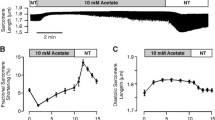Summary
Palmitate uptake by isolated, calcium-resistant cardiomyocytes was measured by using a stimulation chamber in which cell contraction can be evoked electrically. Experiments were performed in a medium containing physiological interstitial concentration of albumin (2%) and palmitate/albumin (P/A) ratios ranging from 0.03 to 2.5, and were compared to experiments with fixed P/A ratio (− 1).
Initial rate of uptake (Vi) was calculated from fitted uptake vs. time curves as measured by accumulation of radioactivity in the cells from 14C-labelled palmitate. Vi-vs.-concentration curves exhibited a saturable component, if albumin concentration was kept constant. Almost no change in Vi was observed in experiments performed at constant P/A. This is in contrast to the albumin receptor hypothesis.
The 14C-palmitate content of the myocytes as estimated by thin-layer-chromatography did reach a plateau at ⩽30 s and had the same value at 30 min after administration. The cellular content of labelled palmitate could be attributed to the membrane compartment as calculated from partition coefficient (Kc) of fatty acids (FA) between albumin and membranes. With electrical stimulation Vi-vs.-palmitate concentration kinetics showed a shift in apparent Km from 62 µM (P/A − 0.22) to 23 µM (P/A = 0.08), and presence of 2,4-dinitrophenol increases Vi.
Our results suggest that FA-transfer across the sarcolemmal membranes is determined by a physicochemical equilibrium between the compartments of extracellular FA-albumin complex, the membrane lipid phase, intracellular FA binding proteins and the respective aqueous phases. Consequently in cell suspensions the rate of palmitate uptake is controlled by a step of fatty acid metabolism possibly the formation of Fa CoA by the enzyme FA acyl CoA synthetase which is localized in membranes of endoplasmatic reticulum and mitochondria. This step is influenced by the metabolic state of the cells and by FA concentration in membranes.
Similar content being viewed by others
References
Weisiger R, Gollan J, Ockner R: Receptor for albumin on the liver cell surface may mediate uptake of fatty acids and other albumin bound substances. Science 211: 1048–1051, 1981
Hütter JF, Piper HM, Spiekermann PG: Myocardial fatty acid oxidation suggesting an albumin receptor mediated uptake process. J Moll Cell Cardiol 16: 219–226, 1984
Rauch B, Bode C, Piper HM, Hütter JF, Zimmermann R, Braunwell E, Hasselbach W, Kübler W: Palmitate uptake in calcium tolerant, adult rat myocardial single cells — evidence for an albumin mediated transport across sarcolemma. J Mol Cell Cardiol 19: 159–166, 1987
Stremmel W: Fatty acid uptake by isolated rat heart myocytes represents a carrier mediated transport process. J Clin Invest: 81: 844–852, 1988
Weisiger RA: Dissociation from albumin: a potentially rate-limiting step in the clearance of substances by the liver. Proc Natl Acad Sci USA 82: 1563–1567, 1985
DeGrella RF, Light RJ: Uptake and metabolism of fatty acid by dispersed adult rat heart myocytes. J Biol Chem 255: 9739–9745, 1980
Aas M: Organ and subcellular distribution of fatty acid activating enzymes in the heart. Biochim Biophys Acta 231: 32–47, 1971
Noy N, Zakim D: Fatty acids bound to unilamellar lipid vesicles as substrates for microsomal acyl coA Ligase. Biochem 24: 3521–3525, 1985
Rose H, Kammermeier H: Contraction and metabolic activity of electrically stimulated cardiac myocytes from adult rats. Pflügers Arch 407: 116–118, 1986
Heller KB, Jahn B, Deuticke B: Peroxidative membrane damage in human erythrocytes induced by a concerted action of iodoacetate, vanadate and ferricyanide. Biochim Biophys Acta 901: 67–77, 1987
Korte K, Casey L: Phospholipid and neutral lipid separation by one-dimensional thin-layer chromatography. J Chromat 232: 47–53, 1982
Bröring K, Haest CWM, Deuticke B: Fast translocation of long fatty acids across the erythrocyte membrane. Biol Chem Hoppe Seyler, in Press, 1989
Noy N, Donnelly TM, Zakim D: Physico-chemical model for the entry of water-insoluble compounds into cells. Studies of fatty acid uptake by the liver. Biochem 25: 2013–2021, 1986
Author information
Authors and Affiliations
Rights and permissions
About this article
Cite this article
Rose, H., Hennecke, T. & Kammermeier, H. Is fatty acid uptake in cardiomyocytes determined by physicochemical fatty acid partition between albumin and membranes?. Mol Cell Biochem 88, 31–36 (1989). https://doi.org/10.1007/BF00223420
Accepted:
Issue Date:
DOI: https://doi.org/10.1007/BF00223420




